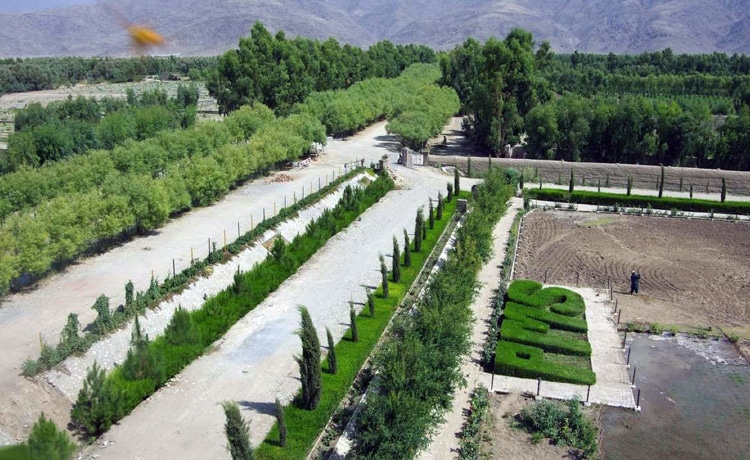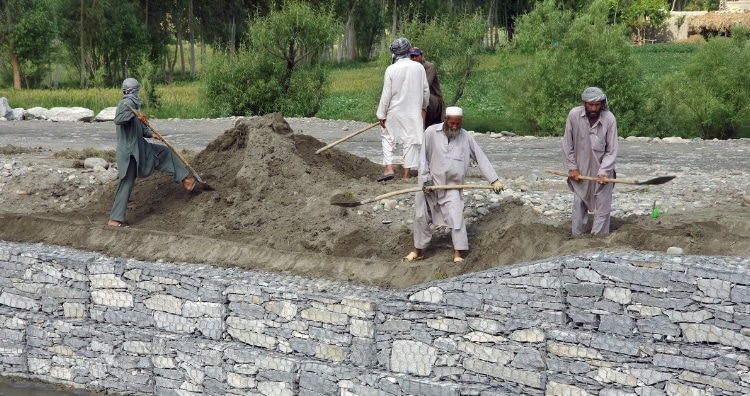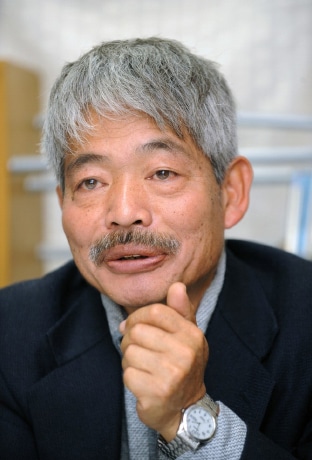【In the land of the Afghans – Reports from Dr. Tetsu Nakamura】 The War on Terrorism: 15 years of suffering
Published on July 12, 2015 – the Nishinippon Newspaper
It is with a sense of great reluctance that I have to talk about the consequences of the so-called “Reconstruction of Afghanistan” that involved massive amounts of money. Hunger and drought still persist around the country, and 7.6 million people, a full one-third of the population, are starving according to the World Food Program (WFP). The true reality of these consequences is largely unknown.
People have lost faith in the “information society” that reports only on war and politics and not this reality. It is believed that two-thirds of the province of Nangarhar, where PMS (Peace Japan Medical Services) works, is already under the control of the IS. There is no reason for us to be against them, but it must be noted that a map of their territory overlaps perfectly with the area where starvation is the most pronounced.
Locals openly say that “The white Taliban flag pays us just 5,000 AFN (10,000 JPY), but the black IS flag pays us 450 USD (50,000 JPY). Not just that. The black flag has the latest weaponry from the big countries. What to do?”
This situation is more about survival rather than ideology. Locals understand the reality only too well.
“IS manipulates information and incites fear in people. They build up their strength with large amounts of armaments and funding. They don’t hesitate when it comes to destruction. This is just like what the US military does.” They also add, “We are sick of this. Whoever comes won’t change our lives.”
These are the real sentiments of residents 15 years after the War on Terrorism. They become mercenaries to sustain their families as they grieve the loss of loved ones and repeatedly switch sides, all for the sake of survival. This indomitable resilience, or rather the dilemma emerging from this inconsistency is hard to downplay. After all, they are the victims of war.
■“Revelations in the Desert”
The desert is beautiful and quiet. Daytime temperatures approach 50 degrees Celsius, and the fierce sunshine stifles all living things. People simply bow down and ask for blessings in the harshness that is beyond their control. This dignified feature of the Gamberi Desert remains unchanged over time.
However, from the erosion control forest, the scenery dramatically changes. This forest area is approximately 300 meters wide and stretches 5 kilometers separating the desert from local communities. Upon leaving the dark gaz /tamarisk forest with trees at a height of over 10 meters, a single canal flows across the landscape. Rows of willow trees on both sides of the waterway are gentle on the eyes and you can hear birds singing. There are tens of thousands of fruit trees, and the surrounding farmland is rich in watermelons, vegetables, rice, and wheat. Cultivation continues to expand. Since the construction of the canal 6 years ago, it has certainly been contributing to the area’s development.
Back then, I was leading the construction based in a small and shabby hut. Surrounded by intense heat and sandstorms, we swallowed grains of sand mixed into our meals. Hundreds of workers continued working even when pushed to the limit of their exhaustion. Providing their families with three meals a day and living in their homeland was their only wish.
That “command hut” has now turned into a memorial tower of our project in a spacious memorial park. The view of the green expanse of forest rushing towards the desert from the top of this tower is overwhelming. The blessing of nature’s providence beyond human comprehension is there to behold. Everyone is more and more convinced that this is a divine revelation and not just a chance of good fortune.
■ ■
This sight appearing at a corner of the desert is vividly imprinted in everyone's mind. Our staff and the local villagers are working on the construction of intake weirs one after another in the neighboring area, and are eager to revive the breadbasket of eastern Afghanistan. In these 15 years, weirs have been built in many areas and the Green Ground Project is nearing completion. By 2020, PMS is aiming to recover 16,500 hectares of arable land to secure the lives of 650,000 farmers and their families.
PMS’s goal is for nationwide dissemination of our irrigation method with a planning period of five years. It is said that in Afghanistan, irrigated land represents only around 2 million hectares out of 7.7 million hectares of all agricultural land, and it is steadily decreasing.
The drought caused by climate change has finally brought a degree of concern to Afghan politicians. Even if the entire country cannot be saved, the water intake technology developed by PMS is expected to bring benefits to many regions across the country, and the momentum towards nationwide dissemination is increasing. We have called for a “great alliance” that cuts across all interest groups, regardless of their tribe or political position, while surveys and planning activities are already underway.
■ ■
No one wishes to put food on their table by the loss of human lives. It is best to cultivate and live on your own land. Those who have to live under conflict find hope in PMS's irrigation projects. Their prayers are in earnest.
This situation is hard to convey to people living in Japan. The reality behind the conflict is little known and this makes it difficult for people to imagine how poor people are being victimized.
The recent debate on the Japanese security legislation is a sad development. Joining in destruction and the taking of people’s lives for economic benefit is unacceptable. Enough is enough. The so-called “peace” has been ratified and imposed with hands stained in blood. Wealth and peace are often incompatible. Which path will the Japanese people choose?
We repeatedly reflect on the “revelations in the desert” and advocate for reconciliation.
* This includes the reinterpretation of the Constitution by the Japanese government which allows the Self-Defense Force to exercise its right to collective self-defense. The legislation was enacted in September 2015. (Caption added by the translator)
× ×
This is a translation of a report from Afghanistan by Dr. Tetsu Nakamura, a Japanese medical doctor who was gunned down on December 4, 2019 in Afghanistan at the age of 73. Dr. Nakamura was the head of the international NGO, Peace Japan Medical Services (PMS). In addition to medical services, PMS provides various forms of assistance to local communities in Afghanistan’s eastern Nangarhar province, including the construction of irrigation systems, related agricultural programming and provision of food support. PMS is funded by Peshawar-kai, which was established in 1983 to collect donations from people and support the project implementation of Dr. Nakamura and his team.
This report is one of 27 installments in the series “In the Land of the Afghans – Reports from Dr. Tetsu Nakamura”, which ran from May 25, 2009 to December 2, 2019. These articles were originally published by the local newspaper in Dr. Nakamura’s hometown in Fukuoka, Japan. The text has been translated from Japanese to English, with the support of Peshawar-kai, by more than 30 volunteers, many of whom work in the field of humanitarian and development aid, and who have been and will continue to be inspired by Dr. Nakamura's work and philosophy.




